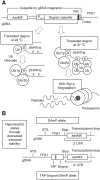Mutant power: using mutant allele collections for yeast functional genomics
- PMID: 26453908
- PMCID: PMC5065357
- DOI: 10.1093/bfgp/elv042
Mutant power: using mutant allele collections for yeast functional genomics
Abstract
The budding yeast has long served as a model eukaryote for the functional genomic analysis of highly conserved signaling pathways, cellular processes and mechanisms underlying human disease. The collection of reagents available for genomics in yeast is extensive, encompassing a growing diversity of mutant collections beyond gene deletion sets in the standard wild-type S288C genetic background. We review here three main types of mutant allele collections: transposon mutagen collections, essential gene collections and overexpression libraries. Each collection provides unique and identifiable alleles that can be utilized in genome-wide, high-throughput studies. These genomic reagents are particularly informative in identifying synthetic phenotypes and functions associated with essential genes, including those modeled most effectively in complex genetic backgrounds. Several examples of genomic studies in filamentous/pseudohyphal backgrounds are provided here to illustrate this point. Additionally, the limitations of each approach are examined. Collectively, these mutant allele collections in Saccharomyces cerevisiae and the related pathogenic yeast Candida albicans promise insights toward an advanced understanding of eukaryotic molecular and cellular biology.
Keywords: Candida albicans; Saccharomyces cerevisiae; functional genomics; overexpression; transposon; yeast.
© The Author 2015. Published by Oxford University Press. All rights reserved. For permissions, please email: journals.permissions@oup.com.
Figures



Similar articles
-
Genome-wide transposon mutagenesis in Saccharomyces cerevisiae and Candida albicans.Methods Mol Biol. 2011;765:207-24. doi: 10.1007/978-1-61779-197-0_13. Methods Mol Biol. 2011. PMID: 21815095 Free PMC article.
-
Gene Essentiality Analyzed by In Vivo Transposon Mutagenesis and Machine Learning in a Stable Haploid Isolate of Candida albicans.mBio. 2018 Oct 30;9(5):e02048-18. doi: 10.1128/mBio.02048-18. mBio. 2018. PMID: 30377286 Free PMC article.
-
Large-scale essential gene identification in Candida albicans and applications to antifungal drug discovery.Mol Microbiol. 2003 Oct;50(1):167-81. doi: 10.1046/j.1365-2958.2003.03697.x. Mol Microbiol. 2003. PMID: 14507372
-
Chemical-genetic approaches for exploring the mode of action of natural products.Prog Drug Res. 2008;66:237, 239-71. doi: 10.1007/978-3-7643-8595-8_5. Prog Drug Res. 2008. PMID: 18416308 Review.
-
Functional profiling of human fungal pathogen genomes.Cold Spring Harb Perspect Med. 2014 Nov 6;5(3):a019596. doi: 10.1101/cshperspect.a019596. Cold Spring Harb Perspect Med. 2014. PMID: 25377143 Free PMC article. Review.
Cited by
-
Pathway Analysis of Fucoidan Activity Using a Yeast Gene Deletion Library Screen.Mar Drugs. 2019 Jan 14;17(1):54. doi: 10.3390/md17010054. Mar Drugs. 2019. PMID: 30646537 Free PMC article.
-
Advances in Molecular Tools and In Vivo Models for the Study of Human Fungal Pathogenesis.Microorganisms. 2020 May 26;8(6):803. doi: 10.3390/microorganisms8060803. Microorganisms. 2020. PMID: 32466582 Free PMC article. Review.
-
Protein Moonlighting Revealed by Noncatalytic Phenotypes of Yeast Enzymes.Genetics. 2018 Jan;208(1):419-431. doi: 10.1534/genetics.117.300377. Epub 2017 Nov 10. Genetics. 2018. PMID: 29127264 Free PMC article.
-
Practical Approaches for the Yeast Saccharomyces cerevisiae Genome Modification.Int J Mol Sci. 2023 Jul 26;24(15):11960. doi: 10.3390/ijms241511960. Int J Mol Sci. 2023. PMID: 37569333 Free PMC article. Review.
-
Systematic Identification of Essential Genes Required for Yeast Cell Wall Integrity: Involvement of the RSC Remodelling Complex.J Fungi (Basel). 2022 Jul 8;8(7):718. doi: 10.3390/jof8070718. J Fungi (Basel). 2022. PMID: 35887473 Free PMC article.
References
Publication types
MeSH terms
Substances
Grants and funding
LinkOut - more resources
Full Text Sources
Other Literature Sources
Molecular Biology Databases

